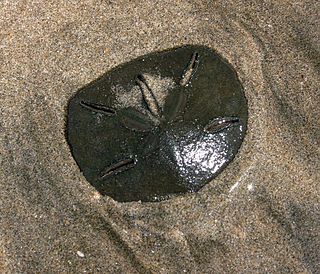
Sea urchins or urchins are typically spiny, globular animals, echinoderms in the class Echinoidea. About 950 species live on the seabed, inhabiting all oceans and depth zones from the intertidal to 5,000 metres. Their tests are round and spiny, typically from 3 to 10 cm across. Sea urchins move slowly, crawling with their tube feet, and sometimes pushing themselves with their spines. They feed primarily on algae but also eat slow-moving or sessile animals. Their predators include sea otters, starfish, wolf eels, and triggerfish.

Sand dollars are species of flat, burrowing sea urchins belonging to the order Clypeasteroida. Some species within the order, not quite as flat, are known as sea biscuits. Sand dollars can also be called "sand cakes" or "cake urchins".

Diadema setosum is a species of long-spined sea urchin belonging to the family Diadematidae. It is a typical sea urchin, with extremely long, hollow spines that are mildly venomous. D. setosum differs from other Diadema with five, characteristic white dots that can be found on its body. The species can be found throughout the Indo-Pacific region, from Australia and Africa to Japan and the Red Sea. Despite being capable of causing painful stings when stepped upon, the urchin is only slightly venomous and does not pose a serious threat to humans.

Astropyga radiata, the red urchin, fire urchin, false fire urchin or blue-spotted urchin, is a species of sea urchin in the family Diadematidae. It is a large species with long spines and is found in the tropical Indo-Pacific region. It was first described in 1778 by the German naturalist Nathaniel Gottfried Leske.

Heterocentrotus mamillatus, commonly known as the slate pencil urchin, red slate pencil urchin, or red pencil urchin, is a species of tropical sea urchin from the Indo-Pacific region.

Mellita quinquiesperforata is a tropical species of sand dollar, a flat, round marine animal related to sea urchins, starfish, and other echinoderms. They can be found along the eastern coast of the United States and the coast of Brazil.

The heart urchins or Spatangoida are an order of sea urchins.

Dendraster excentricus, also known as the eccentric sand dollar, sea-cake, biscuit-urchin, western sand dollar, or Pacific sand dollar, is a species of sand dollar in the family Dendrasteridae. It is a flattened, burrowing sea urchin found in the north-eastern Pacific Ocean from Alaska to Baja California.

The sea urchins of the Gulf of California live between the coasts of the Baja California Peninsula to the west and mainland state of Sonora, Mexico to the east. The northern boundary is the lateral band of land with the remains of the Colorado River Delta, and the southern is the Pacific Ocean.

Asthenosoma varium is a sea urchin. Growing up to 25 cm (10 in) in diameter, it lives on sand and rubble sea bottoms in the Indo-Pacific, from the Red Sea to Australia and Southern Japan. Its venom tipped spines, with distinctive globular swellings below the tip, can inflict a painful sting if handled; the pain lasts as long as several hours. This capacity, perhaps coupled with its reddish-brown colour, has given it the common name fire urchin; other commonly used names are Pacific fire urchin, elusive sea urchin, variable fire urchin, and electric sea urchin.

Dorippe frascone, the urchin crab or carrier crab, is a small species of crab in the family Dorippidae that was first described scientifically by J.F.W. Herbst, in 1785. It is found in the Red Sea and parts of the western and eastern Indian Ocean. It often has a symbiotic relationship with a long-spined sea urchin and carries one around on its carapace.

Brissus unicolor is a species of sea urchins of the family Brissidae. Their armour is covered with spines. Brissus unicolor was first scientifically described in 1778 by Nathanael Gottfried Leske.

Clypeasteridae is a family of sea urchins in the order Clypeasteroida. This family was first scientifically described in 1835 by the Swiss-American biologist Louis Agassiz.

Clypeaster rosaceus, the fat sea biscuit, is a species of sea urchin in the family Clypeasteridae. It occurs in shallow water in the western Atlantic Ocean and was first scientifically described in 1758 by Carl Linnaeus.

Clypeaster humilis is a species of sea urchin in the family Clypeasteridae. This species was first scientifically described in 1778 by the German biologist Nathanael Gottfried Leske. It occurs in the tropical Indo-Pacific region.

Leodia sexiesperforata, commonly known as the six-holed keyhole urchin, is a species of sand dollar, in the echinoderm order Clypeasteroida. It is native to tropical and sub-tropical parts of the western Atlantic Ocean where it buries itself in soft sediment in shallow seas.

Parechinus angulosus, the Cape urchin, is a sea urchin in the family Parechinidae endemic to southern Africa. It is the only species in the genus Parechinus.

Encope emarginata, a notched sand dollar, is a marine echinoid ranging the western Atlantic ocean. They are best known for their bioturbation in the sediment, relationship with crabs, and their widespread distribution.

Mespilia globulus, the globular sea urchin, sphere sea urchin, or tuxedo urchin, is a sea urchin occurring in tropical shallow reef habitats. The specific name refers to a small ball or spherule, describing its overall shape/morphology. It is the only species in the genus Mespilia.


















